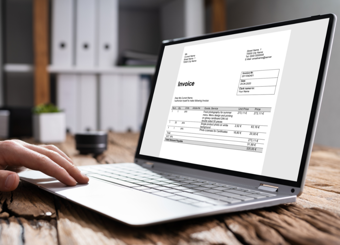5 reputation-saving ways to avoid late payment
It’s estimated that 1 in 3 payments to small and medium businesses are late, according to The Federation of Small Businesses, with The Guardian reporting that late payments are estimated to cost the UK economy £2.5bn a year. In fact, many businesses write off thousands of pounds of bad debt every year, often because they’re too embarrassed to chase for payments, or in fear of antagonizing corporate customers.
To try to curb this unwelcome phenomenon, the government has reinforced the late payment publishing regulation this year so they can shine a light on bad practices and increase business supply chain payment transparency. Under the new law, organizations have to disclose their payment terms, the average time taken to pay, as well as any late payment owned and paid annually. Information will have to be submitted to a central digital location which means the public will have access to all the information, and failure to report will be a criminal offence.
Needless to say, no organization wants to be named and shamed, and for any Finance, or specifically Accounts Payable (AP) team, it means pressure to avoid the finger of responsibility being pointed from the boardroom of: ‘if we pay our suppliers late, it’s all your fault’. Indeed, current unethical practices can not only bring a business’ reputation into question, but also create damaging consequences for supplier relationships.
At best, if goodwill is lost with an important supplier then the next favor to be called in could well fall on deaf ears, or at worst the supplier’s cash flow is put in such dire straits they can’t continue to fulfill their commercial commitments at all. So there’s a strong case to make eliminating late payments one of your top priorities. To help, we’ve put together this 5 steps guide to achieving invoice processing best practice.
Create accountability with clear KPIs and lean processes
Start measuring performance by setting some clear targets around supplier payment such as average debtor days, early payment discount activation rate, or late payment penalty maximums. Also, look into how your team processes invoices – are there processes that create bottlenecks, or unnecessary steps you can eliminate? You can also consider automating manual administrative tasks, which can reduce the turnaround time for paying invoices significantly. This should help you iron out the issues that are tipping your AP function towards an accepted culture of making late payments.
Establish a standard workflow and communication process
How do you communicate with your team members, and your suppliers? Ideally, you should have roles and responsibilities clearly communicated with team members so that everyone knows who’s doing specific tasks such as processing the different types of invoice formats, handling exceptions, or delegating and escalating the more exceptional tasks when necessary. This can help with standardizing and improving workflow, and ensure your team can allocate the right resources to address any issue in a timely manner, before payments are pushed beyond agreed credit terms.
An accounts payable automation system can give all your stakeholders full visibility into the AP workload status. With real-time information about invoice status and associated actions available for all those authorized to see, team members can collaborate better, while suppliers can find the information they need without calling in or emailing you to chase for any payment. Also, why limit your team to the bounds of your office? Allow your employees to work wherever they may be with an application that’s optimized for mobile devices.
Collaborate better with your suppliers
We all know late payment isn’t always the fault of the buying organization. Far from it, sometimes suppliers send invoices in the wrong format or with inaccurate information, especially the ‘long tail’ of suppliers that invoice less frequently. To minimize the inevitable delay when it arrives into the business, set out clear invoicing guidelines and provide templates to assist suppliers, so they can bill you in the right format.
Alternatively, there are systems, commonly known as supplier portals, that allow suppliers to submit their invoices by using standard online templates that guarantee compliance with the fields and formats your finance system will accept. A best-of-breed system, such as Medius Accounts Payable Automation, provides an easy-to-use supplier portal with auto validation functionality to ensure that invoices are always correct and consistent.
Create frictionless invoicing for your top tier suppliers
Pareto’s Law applies to many buying organizations that can count on 80% of invoices coming from 20% of their suppliers. By enabling frictionless invoicing between suppliers’ billing systems and your own finance back end or ERP for suppliers with high transaction volumes, there are huge benefits to be found in eliminating manual and potentially error-prone processes like scanning and re-keying.
An integration between your invoicing system and your suppliers’ finance system allows them to send invoices directly to you without any human interference. By achieving a completely touchless invoicing process, you can speed up your entire invoice cycle and eliminate the vast majority of human touchpoints.
Medius Accounts Payable Automation has an integration option for high-value suppliers, where they can make use of one of our invoice standard data formats or we can map to any format of their choosing. We also have a ready-made network of connected suppliers, meaning that customers can enjoy the pre-established integrations we have already established with hundreds of large suppliers across the globe, making the process of switching to the integrated route even more simple and cost-effective.
Tier your supplier’s invoicing methods
Supply chains can typically be broken into three main tiers when it comes to invoice processing, relating to the size of the supplier and the volume of invoice transactions. By putting your suppliers in the right tiers you’re gearing up for a much leaner and more efficient invoice processing operation. You should look to segment your suppliers according to their billing volumes, size and technical maturity.
As mentioned in our 4th tip, top tiers suppliers can be mandated to establish a direct integration with your system. As for suppliers that prefer to send invoices as email attachments, you can enable that by implementing a solution that automatically reads the document and extracts the data for processing. Alternatively, suppliers can opt for keying in or uploading invoices using a standard template via a dedicated portal (as per tip 3). By offering the right invoicing method to the right group of suppliers, you can ensure touchless invoice processing for improved efficiency and accuracy.
Want to know more about speeding up your accounts payable processes to reduce supplier late payments? Get in touch and we'd be delighted to help.






